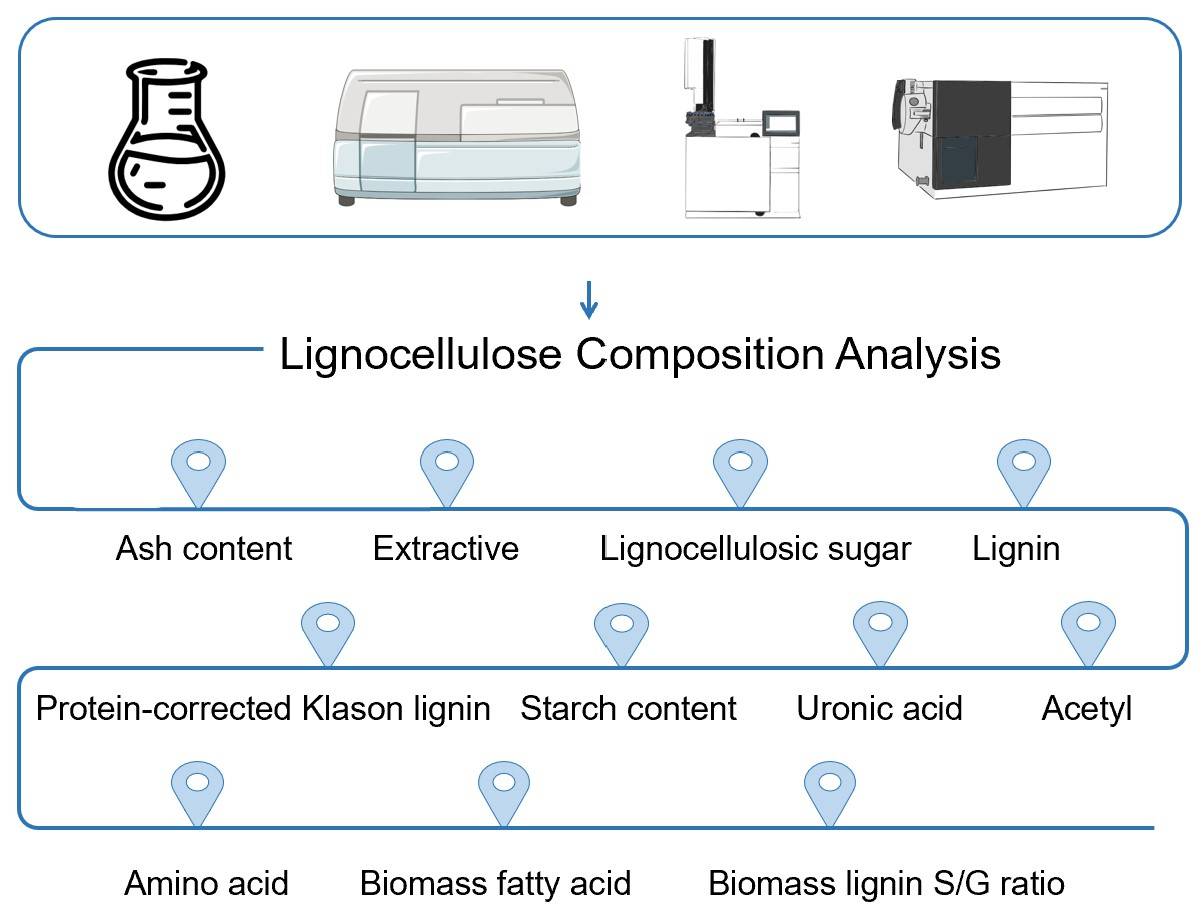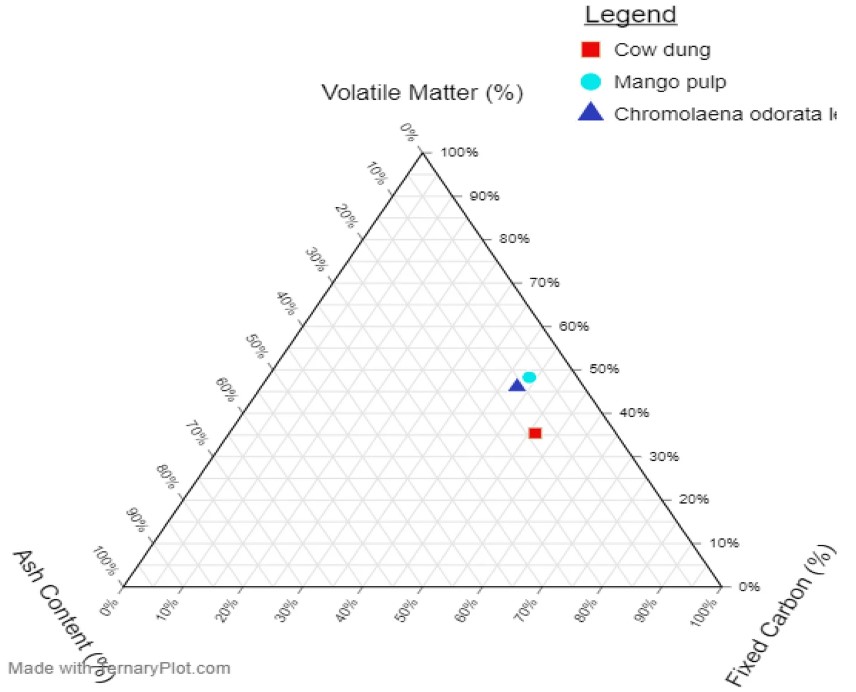Lignocellulose Quantitative Profiling Services
Unraveling the Mysteries of the Components in Lignocellulose with Ease and Precision
Lignocellulosic biomass composition analysis is important for lignocellulosic selection and conversion process research. Creative Biolabs provides highly reproducible, stable, and accurate biomass lignocellulose composition analysis services with detailed data and analytical reports to assist our clients in various types of research. Our analytical services apply to a wide range of sample types and applications such as Biomass conversion, biofuel production, and bioproduct development.
Lignocellulosic biomass contains a variety of components, including lignin, cellulose, hemicellulose, and others. It is necessary to combine multiple methods in the process of component analysis. We have optimized and validated the methods for the analysis of each component of lignocellulose. The validation results show good repeatability, stability, and accuracy of all methods.
-
Various techniques and instruments used for analysis
-
Gas chromatography-mass spectrometry (GC-MS): It is used for the analysis of lignin syringyl / O guaiacyl ratio, fatty acids, etc.
-
Infrared spectrophotometer: It is used for the analysis of different types of lignin, extractives, etc.
-
Elemental analyzer: It is used to detect nitrogen, sulfur, hydrogen, and carbon content in samples.
-
Ion-exchange chromatography (ICE): It is used for the analysis of various monosaccharides, glucuronic acid, acetyl content, etc.
-
Biomass lignocellulose composition analysis process
-
Sample treatment
Samples are pre-treated with drying, grinding, extraction, hydrolysis, etc., according to the type of sample and the purpose of the test.
-
Composition analysis
-
Cellulose and hemicellulose analysis: Cellulose is a polymer composed of glucose. Hemicellulose is composed of more components, including xylose, galactose, galactose, glucuronic acid, etc. We test for lignocellulosic sugar, uronic acid, etc., in each sample.
-
Lignin analysis: We analyze different types of lignin content, protein-corrected Klason lignin, lignin S/G ratio, and so on.
-
In addition to cellulose, hemicellulose, and lignin, for further compositional identification, we also perform extractives analysis, major elements (nitrogen, sulfur, hydrogen, and carbon) analysis, starch content analysis, ash content, etc. The moisture content and acetyl content of lignocellulosic biomass are also a key parameter in the application process. We also test the moisture content in the samples.

We take care of the full compositional analysis of lignocellulosic biomass. Clients also choose any of our services below. After understanding the client's needs, our analysts develop the most relevant experimental plan and carry out the relevant analysis.
Features of Our Biomass Lignocellulose Composition Analysis Services
-
Experienced: We have rich experience in lignocellulosic composition analysis. Our experimenters are skilled in handling various samples and coping with various problems encountered in the analysis.
-
Perfect analysis system: Based on the analysis system of GC-MS, infrared spectroscopy, ICE, etc., we provide accurate composition detection and analysis services.
-
Professional analytical guidance: our analysts help clients better understand the individual components of lignocellulose and provide some appropriate suggestions for the selection and conversion process of lignocellulose.
Creative Biolabs provides professional biomass lignocellulose composition analysis services with a comprehensive testing system and excellent after-sales service. We not only help clients understand the composition of lignocellulose but also provide some suggestions and discussions on how to screen raw materials and use lignocellulose in a better way. Please feel free to contact us for more details if you are interested in our biomass lignocellulose composition analysis services.
Published data
Physicochemical characterization of lignocellulosic biomass is essential for its maximum utilization. In this study, the physicochemical properties of three lignocellulosic biomasses (Chromolaena odorata leaves, mango pulp, and cow dung) were examined, including compositional and calorimetric analyses. The results showed that there were differences in ash, fixed carbon, and calorific range in the three biomasses, but all of them were suitable for the development of energy substances for industrial use. This study provides a demonstration for lignocellulosic biomass compositional analysis and assessment of the utilization value of biomass.
 Fig.1 Ternary plot of volatile matter (%), ash content (%), and fixed carbon (%) on a wet basis.1, 2
Fig.1 Ternary plot of volatile matter (%), ash content (%), and fixed carbon (%) on a wet basis.1, 2
FAQs
Q1: Can lignocellulosic composition analysis help assess the quality of biomass feedstocks?
A1: Lignocellulosic composition analysis provides key information for assessing the quality and suitability of lignocellulosic feedstocks for specific applications. It helps to screen plant species and varieties for specific purposes and also makes it possible to achieve efficient conversion of lignocellulose.
Q2: What techniques are commonly used in lignocellulose composition analysis?
A2: Lignocellulosic composition analysis uses a range of techniques including acid hydrolysis, enzymatic treatment, gravimetric analysis, spectrophotometry, chromatography, and mass spectrometry. These techniques allow for the quantification and characterization of cellulose, hemicellulose, lignin, and other components in lignocellulosic samples.
Customer Review
Reassuring Analytical Services
"Biomass lignocellulose composition analysis services at Creative Biolabs greatly exceeded our expectations. They were always responsive and ready to answer any questions. Not only that, but their analysis was very comprehensive and the data was very detailed, helping us to understand the complex structure of the samples faster and better, which in turn helped us to adjust our research promptly. We were very happy to continue working with them in future studies."
Extensive Experience and Knowledge base
"Creative Biolabs has an impressive base of experience and knowledge in analytical tools and techniques such as GC-MS. After understanding our sample types and needs, they developed a very tailored plan for biomass lignocellulose composition analysis. All our time requirements were met while maintaining high-quality work, saving us valuable time for subsequent studies."
References
-
Fajobi, M. O., et al. "Investigation of physicochemical characteristics of selected lignocellulose biomass." Scientific Reports 12.1 (2022): 2918.
-
Under Open Access license CC BY 4.0, without modification.
For Research Use Only.
Related Services


 Fig.1 Ternary plot of volatile matter (%), ash content (%), and fixed carbon (%) on a wet basis.1, 2
Fig.1 Ternary plot of volatile matter (%), ash content (%), and fixed carbon (%) on a wet basis.1, 2



